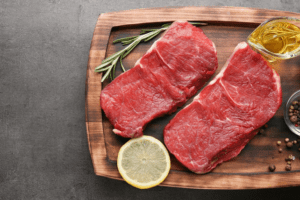
Meat is a crucial part in the diets of most humans and some animals. Even though it has always been animal flesh prepared for consumption, there are different types that vary in nutritional benefits, taste and physical attributes. People can learn more about the features of each major category to make informed decisions about what they eat.
-
Red Meat
Red meat stands out from its counterparts by having a high amount of the protein myoglobin in comparison. This chemical gives the flesh its distinguishing red color. This type of meat comes from livestock animals such as beef, lamb and goat. Pork is a unique in that it is considered red meat nutritionally, but a white meat gastronomically. Red meat is rich in several nutrients including zinc, iron and B-vitamins like thiamin.
-
Poultry
White meat is the counterpart to red meat that lacks the high amount of myoglobin, and as a result, remains pale before and after cooking. Most of this meat originates from birds, formally known as poultry. It is rich in protein and nutrients that include phosphorus and selenium. Poultry types include chicken, turkey and duck. Chicken is particularly popular due to its accessible price and versatility in foods such as fried chicken, spicy teriyaki chicken Yuma AZ and chicken soup.
-
Seafood
Seafood accounts for any meat that comes from creatures who live on the ocean or inside any body of water. It is a wide category that includes fish, mollusks and crustaceans. As a result, it can be difficult to assign a consistent nutritional advantage, but most seafood is a good source of omega-3 fatty acids with low fat. Fish are also generally considered a white meat, with some exceptions like raw tuna.
Meat comes from a plethora of animals, which means there are significant differences between types. Consumers can use information on the three main categories to select the best fit for the situation.